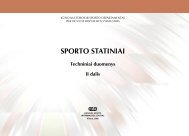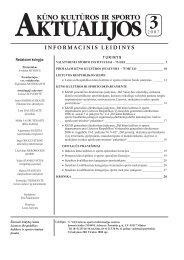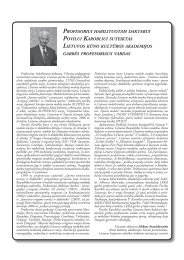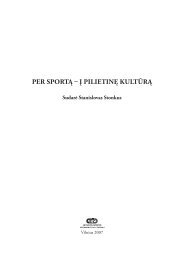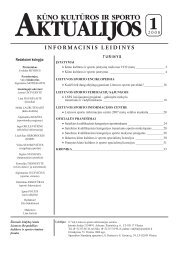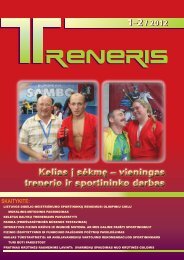Nr. 1 - Lietuvos sporto informacijos centras
Nr. 1 - Lietuvos sporto informacijos centras
Nr. 1 - Lietuvos sporto informacijos centras
Create successful ePaper yourself
Turn your PDF publications into a flip-book with our unique Google optimized e-Paper software.
68<br />
SPORTO MOKSLAS<br />
3. Mūsą naudota rankų koordinacijos lavinimo<br />
programa akivaizdžiai padeda optimizuoti vaikų<br />
fizinį brandinimą mokyklai. Pakitus rankų judesių<br />
kryptingumui ir tikslingumui, kinta rankų judesių<br />
koordinacijos kokybinės ir kiekybinės charakteristikos:<br />
judesiai atliekami laiku, tampa tikslingesni,<br />
racionalesni, ekonomiškesni, tikslesni ir stabilesni.<br />
Gerėja ir regos, lytėjimo, tinkamo raumenų įtempimo<br />
ir nepavėluoto atpalaidavimo jutimas bei atliekamų<br />
judesių suvokimas.<br />
Literatūra<br />
1. Adaškevičienė, E. (1993). <strong>Lietuvos</strong> ikimokyklinukų fizinis<br />
ugdymas. Kaunas: Šviesa.<br />
2. Bruininks, R. H. (2000). Bruininks-Oseretsky test of motor<br />
proficiency. Examiner’s manual. Circle Pines, Minnesota:<br />
American Guidance Service.<br />
3. Bruininks, R. H., Sullivan, L., Short, N. J. (1974). Visualmotor<br />
abilities of disabled and nondisabled children. Paper<br />
present at the 52 nd Annual International Convention of the<br />
Council for Exceptional Children. New York, April 1974.<br />
4. Dankert, H., Davies, P., Gavin, W. (2003). Occupational<br />
therapy effects on visual-motor skills in preschool children.<br />
The American Journal of Occupation Therapy, 57, 542-549.<br />
5. DuRandt, R. (1985). Ball catching proficiency among<br />
4, 6 and 8-year-old girls. In: J. Clark, J. Humphrey (Eds.),<br />
Motor Development: Current Selected Research (pp. 35-44).<br />
Princeton Book Co., Princeton, NJ.<br />
6. Grinienė, E., Lindišienė, D., Maračinskienė, E., Vaitkevičius,<br />
J. (1990). Mokymosi įtaka vaiko ir paauglio organizmui.<br />
Kaunas: Šviesa.<br />
7. Gallahue, D. L., Ozmun, J. C. (2000). Understanding Motor<br />
Development. Champaign, IL: Human Kinetics.<br />
8. Inui, N., Katsura, Y. (2002). Development of force control<br />
and timing in a finger-tapping sequence with an attenuatedforce<br />
tap. Motor Control, 6, 333-346.<br />
9. Kephard, N. C. (1971). The Slow Learning in the<br />
Classroom. Columbus, Ohio: Merrill.<br />
10. Kuhtz-Buschbeck, J. P., Stolze, H., Jöhnk, K., Boczek-<br />
Furcke, A., Illert, M. (1998). Development of prehension<br />
movements in children: a kinematics study. Experimental<br />
Brain Research, 122 (4), 424-432.<br />
11. Marteniuk, R. G., Leavitt, J. L., McKenzie, C. L.,<br />
Athenes, S. (1990). Functional relationships between grasp<br />
and transport components in a prehension task. Human<br />
Movement Science, 9, 149-176.<br />
12. Sinclair, D. (1985). Human Growth after Birth (4 th ed.).<br />
London: Oxford University Press.<br />
13. Søvik, N., Maeland, A. F. (1987). Children with motor<br />
problems on writing: performance of dysgraphic children.<br />
Scandinavian Journal of Educational Research, 28,<br />
129-147.<br />
14. Sugden, D, Chambers, M. (2003). Intervention in children<br />
with developmental coordination disorder: the role of parents<br />
and teachers. British Journal of Educational Psychology,<br />
73, 545-561.<br />
15. Лях, В. И. (2000). Координационные способности<br />
школьников. Физическая культура в школе, 4, 6-13.<br />
16. Михайлова, С. (1990). Развитие координационных<br />
движений у детей 6–7 лет, как основа повышения их<br />
физической подготовленности: дис. канд. пед. наук.<br />
Ленинград.<br />
TRAINING INFLUENCE On 5–7 YEAR OLD CHILDREN<br />
UPPER-LIMBS COORDINATION RESULTS CHANGES<br />
The aim of the study was to examine changes of 5-7<br />
years old children’s upper-limbs coordination results<br />
stimulating their physical maturing for school.<br />
The following research methods were applied:<br />
educational experiment, testing, pedagogical<br />
observation, statistical analysis. The educational<br />
experiment lasted for 20 months. 120 children from<br />
Klaipėda kindergartens participated in the experiment.<br />
The children from the experimental (E) group were<br />
educated according to our created program of physical<br />
preparation for school. The basis of upper-limbs<br />
coordination training consisted of finger, hand, and arm<br />
exercises and ball games. The control (C) group used the<br />
program “Vėrinėlis”, certified by Lithuanian Republic<br />
Ministry of Education. Three control researches were<br />
conducted. The children had to perform five tasks with<br />
a tennis ball and three finger touching exercises which<br />
assess coordination of visual tracking with movements<br />
Summary<br />
Assoc. Prof. Dr. Zina Birontienė<br />
Klaipėda University<br />
of the arms and hands, as well as precise movements of<br />
the arm, hands and fingers.<br />
During the first research obtained upper-limbs<br />
coordination results from groups E and C 5 year old girls<br />
and boys were very similar. During the eight months of<br />
purposeful training of upper-limbs coordination it was<br />
estimated that group E girls significantly statistically<br />
improved (p



